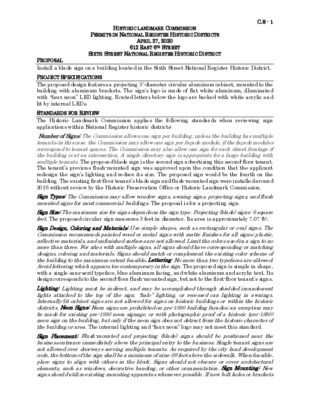C.8.0 - 612 E 6th St.pdf — original pdf
Backup

HISTORIC LANDMARK COMMISSION PERMITS IN NATIONAL REGISTER HISTORIC DISTRICTS APRIL 27, 2020 612 EAST 6TH STREET C.8 - 1 SIXTH STREET NATIONAL REGISTER HISTORIC DISTRICT PROPOSAL Install a blade sign on a building located in the Sixth Street National Register Historic District. PROJECT SPECIFICATIONS The proposed design features a projecting 3’-diameter circular aluminum cabinet, mounted to the building with aluminum brackets. The sign’s logo is made of flat white aluminum, illuminated with “faux neon” LED lighting. Routed letters below the logo are backed with white acrylic and lit by internal LEDs. STANDARDS FOR REVIEW The Historic Landmark Commission applies the following standards when reviewing sign applications within National Register historic districts: Number of Signs: The Commission allows one sign per building, unless the building has multiple tenants; in this case, the Commission may allow one sign per façade module, if the façade modules correspond to tenant spaces. The Commission may also allow one sign for each street frontage if the building is at an intersection. A single directory sign is appropriate for a large building with multiple tenants. The proposed blade sign is the second sign advertising this second-floor tenant. The tenant’s previous flush-mounted sign was approved upon the condition that the applicant redesign the sign’s lighting and reduce its size. The proposed sign would be the fourth on the building. The existing first-floor tenant’s blade sign and flush-mounted sign were installed around 2016 without review by the Historic Preservation Office or Historic Landmark Commission. Sign Types: The Commission may allow window signs, awning signs, projecting signs, and flush mounted signs for most commercial buildings. The proposal is for a projecting sign. Sign Size: The maximum size for signs depends on the sign type. Projecting (blade) signs: 6 square feet. The proposed circular sign measures 3 feet in diameter. Its area is approximately 7.07 ft2. Sign Design, Coloring and Materials: Use simple shapes, such as rectangular or oval signs. The Commission recommends painted wood or metal signs with matte finishes for all signs; plastic, reflective materials, and unfinished surfaces are not allowed. Limit the colors used in a sign to no more than three. For sites with multiple signs, all signs should have corresponding or matching designs, coloring and materials. Signs should match or complement the existing color scheme of the building to the maximum extent feasible. Lettering: No more than two typefaces are allowed. Avoid lettering which appears too contemporary in the sign. The proposed sign is simple in shape, with a single sans-serif typeface, blue aluminum facing, and white aluminum and acrylic text. Its design corresponds to the second-floor flush-mounted sign, but not to the first-floor tenant’s signs. Lighting: Lighting must be indirect, and may be accomplished through shielded incandescent lights attached to the top of the sign, “halo” lighting, or recessed can lighting in awnings. Internally-lit cabinet signs are not allowed for signs on historic buildings or within the historic districts. Neon Signs: Neon signs are prohibited on pre-1950 building facades; an exception may be made for existing pre-1950 neon signage, or with photographic proof of a historic (pre-1950) neon sign on the building, but only if the neon sign does not detract from the historic character of the building or area. The internal lighting and “faux neon” logo may not meet this standard. Sign Placement: Flush-mounted and projecting (blade) signs should be positioned near the business entrance immediately above the principal entry to the business. Single-tenant signs are not allowed over doorways serving multiple tenants. As required by the city land development code, the bottom of the sign shall be a minimum of nine (9) feet above the sidewalk. When feasible, place signs to align with others in the block. Signs should not obscure or cover architectural elements, such as windows, decorative banding, or other ornamentation. Sign Mounting: New signs should utilize existing mounting apparatus whenever possible. If new bolt holes or brackets C.8 - 2 are necessary for sign installation, care should be taken to ensure that installation does not damage historic building materials in any way. Bolting through mortar joints avoids damage to historic stone or brick. The proposed blade sign will be positioned next to the entry to the second floor of the building. The sign’s mounting plan does not specify points of contact on the building. STAFF COMMENTS Existing non-conforming signage in the Sixth Street National Register District will be documented in 2020 as part of an internal study by HPO survey coordination staff. STAFF RECOMMENDATION Discuss methods for removal or modification of existing non-conforming signage. Encourage the applicant to choose either the blade sign or the existing second-floor sign, per design standards. Should the applicant select the proposed design as their primary signage, request changes to the proposed lighting scheme to help better meet the design standards. PROPERTY INFORMATION Photos Existing signage. Source: https://draperstartuphouse.com/austin-texas-us/, 2020.